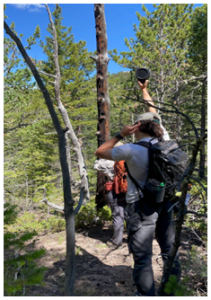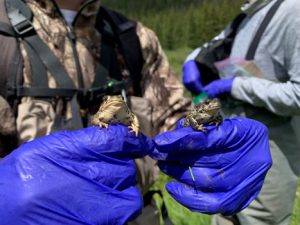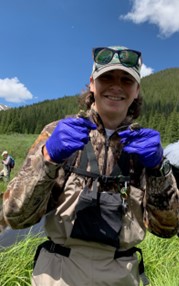Howdy! My name is Tyler Lovato and I am a Fish, Wildlife and Conservation Biology major heading into my fourth year here at CSU. From the time I transferred to a STEM school in the 4th grade I have been a faithful student of the scientific process. Once I started taking biology and environmental courses in high school, I began to see the extreme detrimental impacts of the human agenda. With this knowledge, and my passion for herpetology, wildlife, and the outdoors, I knew conservation biology was what I wanted to pursue. I recently added a minor in Bioinformatics, as I also understand the importance of sorting and analyzing large datasets in environmental science. First, though, you must collect that data, which is where the fieldwork comes in. So, when CNHP staff gave a presentation about data sharing at the annual COPARC (Colorado Partners in Amphibian and Reptile Conservation) meeting in February and mentioned possible internship possibilities, I felt as though the stars had aligned.
 Most of my summer was spent with the US Forest Service in the South Zone of the Arapaho Roosevelt National Forest and Pawnee National Grassland (ARP). I was slated for “Fish Research” out of the Idaho Springs office all summer but when word came through that the head Fisheries Biologist would be taking a detail (and therefore not be around all summer) things became a little uncertain. Still, driving from my parents’ house in Denver to the Idaho Springs office on that first Monday morning, I held a quiet confidence that it would be a great experience. The Fish Bio that would soon be leaving greeted me and introduced me to most of the departments at the office. She then brought me to a corner of the office known as “the pit” (aptly named considering there were sometimes upwards of 6 or 7 technicians crammed in there). It was here where I met the wildlife and fisheries technicians of the ARP South Zone, who would quickly become my best friends for the rest of the summer.
Most of my summer was spent with the US Forest Service in the South Zone of the Arapaho Roosevelt National Forest and Pawnee National Grassland (ARP). I was slated for “Fish Research” out of the Idaho Springs office all summer but when word came through that the head Fisheries Biologist would be taking a detail (and therefore not be around all summer) things became a little uncertain. Still, driving from my parents’ house in Denver to the Idaho Springs office on that first Monday morning, I held a quiet confidence that it would be a great experience. The Fish Bio that would soon be leaving greeted me and introduced me to most of the departments at the office. She then brought me to a corner of the office known as “the pit” (aptly named considering there were sometimes upwards of 6 or 7 technicians crammed in there). It was here where I met the wildlife and fisheries technicians of the ARP South Zone, who would quickly become my best friends for the rest of the summer.
Wildlife Surveys With flows much too high to begin any fish work, I was going out with the wildlife crew every day, helping them conduct their surveys. The primary surveys we conducted were Northern Goshawk (G5 S3B), Flammulated Owl (G4 S4), and Boreal Toad (G4 S1). With my background and interest in herps, you can probably guess which surveys were my favorite. However, I gained valuable knowledge from every experience. Goshawk surveys gave me experience using maps, hiking off-trail, and taught me how to be in the field for a full day with no access to amenities. Bushwhacking and hiking up and down steep ravines gave me a new appreciation for the forest itself and reinforced my admiration of the wildlife that flourishes there. The Flammulated Owl surveys proved to me that the work we were doing would have a real and measurable impact on the forest. One night, after more than an hour of no returned owl calls (other than once from a camper who thought he was communicating with a real bird), we thought it may be another unfruitful survey. Then, we heard the faint but unmistakable hoot of a Flam. As our game-caller recording continued, his return calls grew louder in the cool mountain air. Smiles appeared on our faces as we looked at each other, silently agreeing that we all heard what we heard. After the survey, Cora Marrama, our wildlife biologist (and former Siegele Intern!) explained to us that management of this section of the forest would likely be altered due to our finding. She explained that they would now recommend manual thinning or a prescribed burn over a clearcut or machined thinning.
With flows much too high to begin any fish work, I was going out with the wildlife crew every day, helping them conduct their surveys. The primary surveys we conducted were Northern Goshawk (G5 S3B), Flammulated Owl (G4 S4), and Boreal Toad (G4 S1). With my background and interest in herps, you can probably guess which surveys were my favorite. However, I gained valuable knowledge from every experience. Goshawk surveys gave me experience using maps, hiking off-trail, and taught me how to be in the field for a full day with no access to amenities. Bushwhacking and hiking up and down steep ravines gave me a new appreciation for the forest itself and reinforced my admiration of the wildlife that flourishes there. The Flammulated Owl surveys proved to me that the work we were doing would have a real and measurable impact on the forest. One night, after more than an hour of no returned owl calls (other than once from a camper who thought he was communicating with a real bird), we thought it may be another unfruitful survey. Then, we heard the faint but unmistakable hoot of a Flam. As our game-caller recording continued, his return calls grew louder in the cool mountain air. Smiles appeared on our faces as we looked at each other, silently agreeing that we all heard what we heard. After the survey, Cora Marrama, our wildlife biologist (and former Siegele Intern!) explained to us that management of this section of the forest would likely be altered due to our finding. She explained that they would now recommend manual thinning or a prescribed burn over a clearcut or machined thinning.
 The Boreal Toads were the cutest and most fun part of the summer and getting to survey them almost every week was like a dream come true. Imagine getting paid to catch toads! I had some previous knowledge of Boreal Toads and their decline due to chytrid fungus, but now with the time I took in the office to do research, combined with my time working with the toads in the field, I feel very knowledgeable. I understand their habitat requirements and preferences, and their taxonomy and phylogeny. I learned how to take all the biometric data required for toads, as well as how to swab for chytrid fungus. It was an honor to be a part of the recovery efforts for this species, as they continue to climb back from the brink.
The Boreal Toads were the cutest and most fun part of the summer and getting to survey them almost every week was like a dream come true. Imagine getting paid to catch toads! I had some previous knowledge of Boreal Toads and their decline due to chytrid fungus, but now with the time I took in the office to do research, combined with my time working with the toads in the field, I feel very knowledgeable. I understand their habitat requirements and preferences, and their taxonomy and phylogeny. I learned how to take all the biometric data required for toads, as well as how to swab for chytrid fungus. It was an honor to be a part of the recovery efforts for this species, as they continue to climb back from the brink.
Takeaways This summer was an incredible experience that was just as informative as it was fun. My love of the outdoors and technician work this summer cemented fieldwork as something I will continue to pursue. For the next few summers, I am now looking into wildlife technician positions, and gaining more experience in that capacity. The people I met also reinforced my desires to do graduate school, and I will therefore jump on that opportunity when it arises. The research I conducted in association with the projects I did this summer revealed several topics I hope to pursue in my future education and career. Conservation genetics and phylogenetic taxonomy over classic Linnaean taxonomy are both instrumental in the revival of Boreal Toads and Greenback Cutthroat Trout, and should be used more and more as we work to help the species of our planet. I cannot think of a better spot to start my journey and career than with the Colorado Natural Heritage Program, and I am extremely grateful not only for this opportunity but for the work that they do on a daily basis!
This summer was an incredible experience that was just as informative as it was fun. My love of the outdoors and technician work this summer cemented fieldwork as something I will continue to pursue. For the next few summers, I am now looking into wildlife technician positions, and gaining more experience in that capacity. The people I met also reinforced my desires to do graduate school, and I will therefore jump on that opportunity when it arises. The research I conducted in association with the projects I did this summer revealed several topics I hope to pursue in my future education and career. Conservation genetics and phylogenetic taxonomy over classic Linnaean taxonomy are both instrumental in the revival of Boreal Toads and Greenback Cutthroat Trout, and should be used more and more as we work to help the species of our planet. I cannot think of a better spot to start my journey and career than with the Colorado Natural Heritage Program, and I am extremely grateful not only for this opportunity but for the work that they do on a daily basis!




